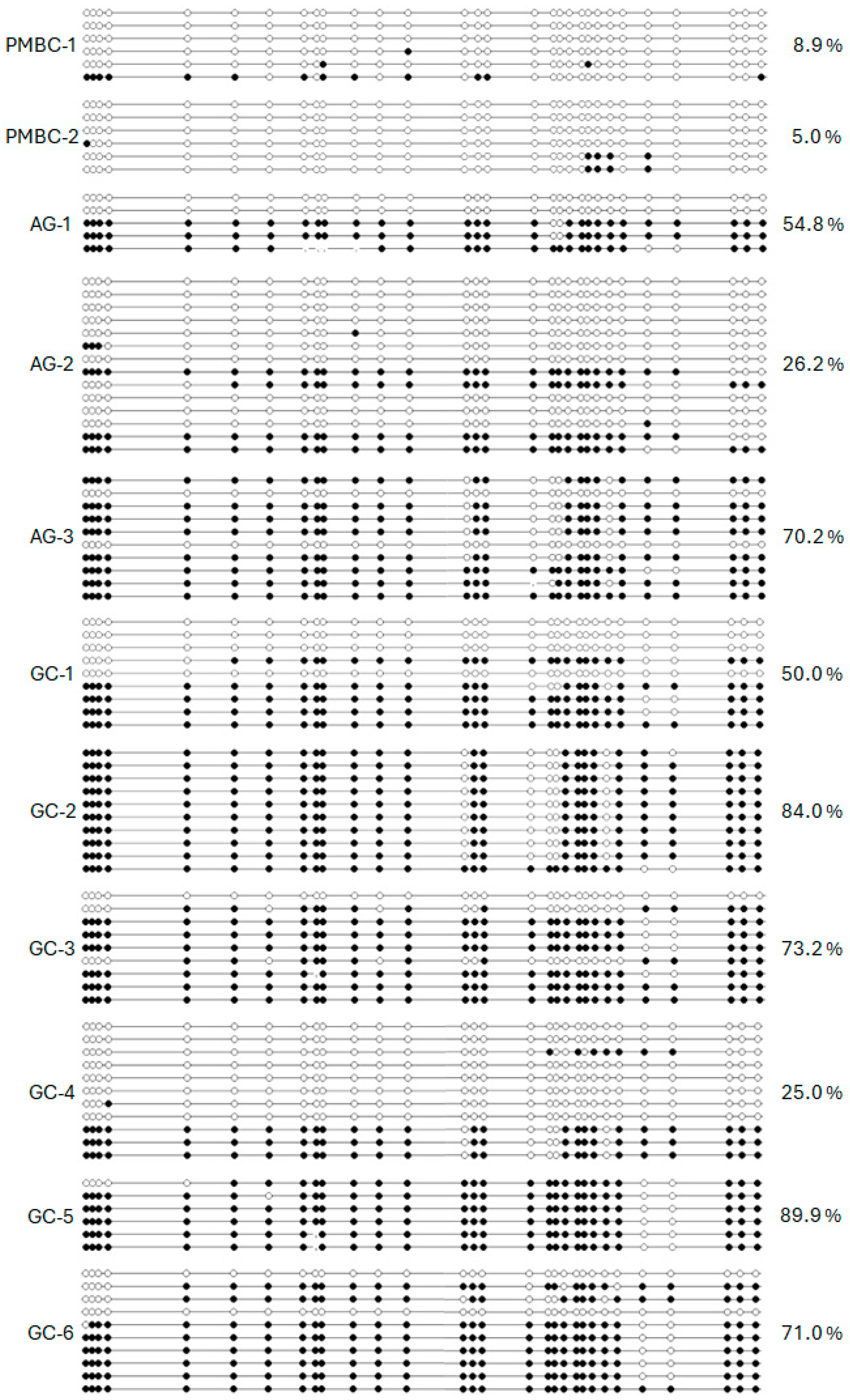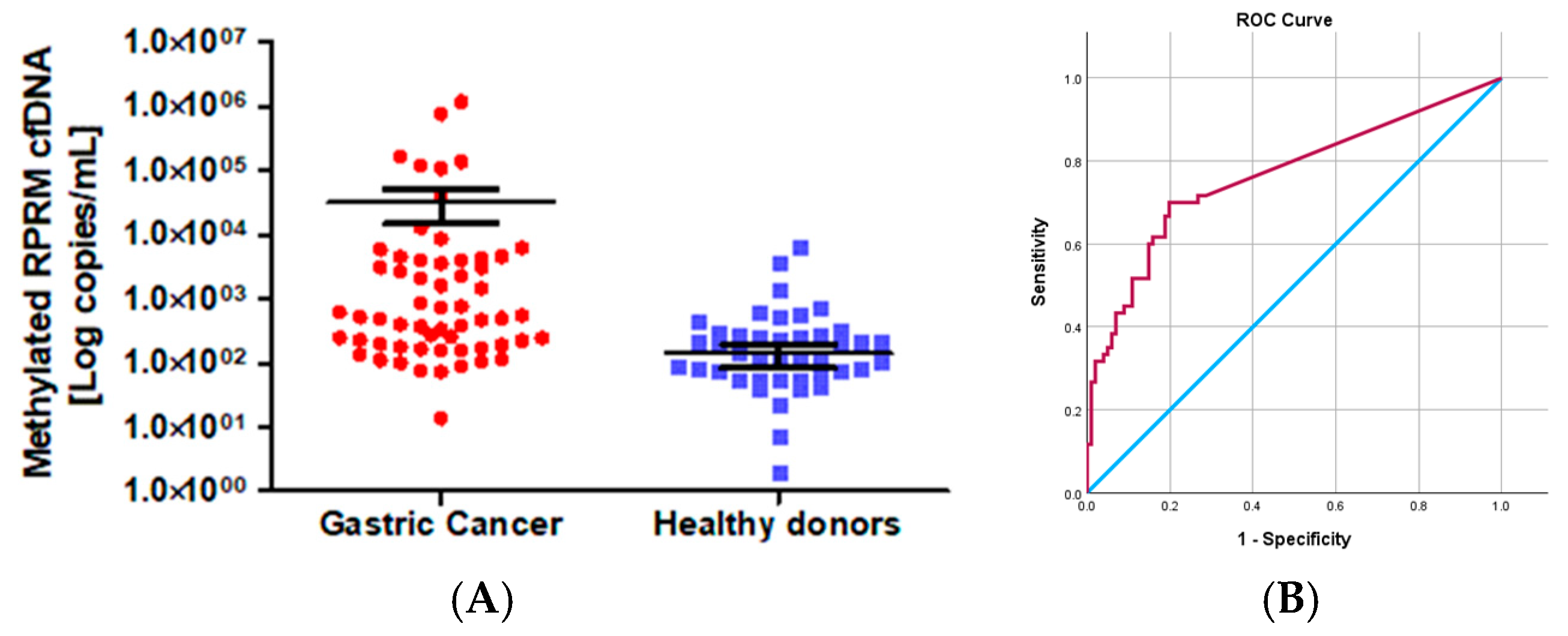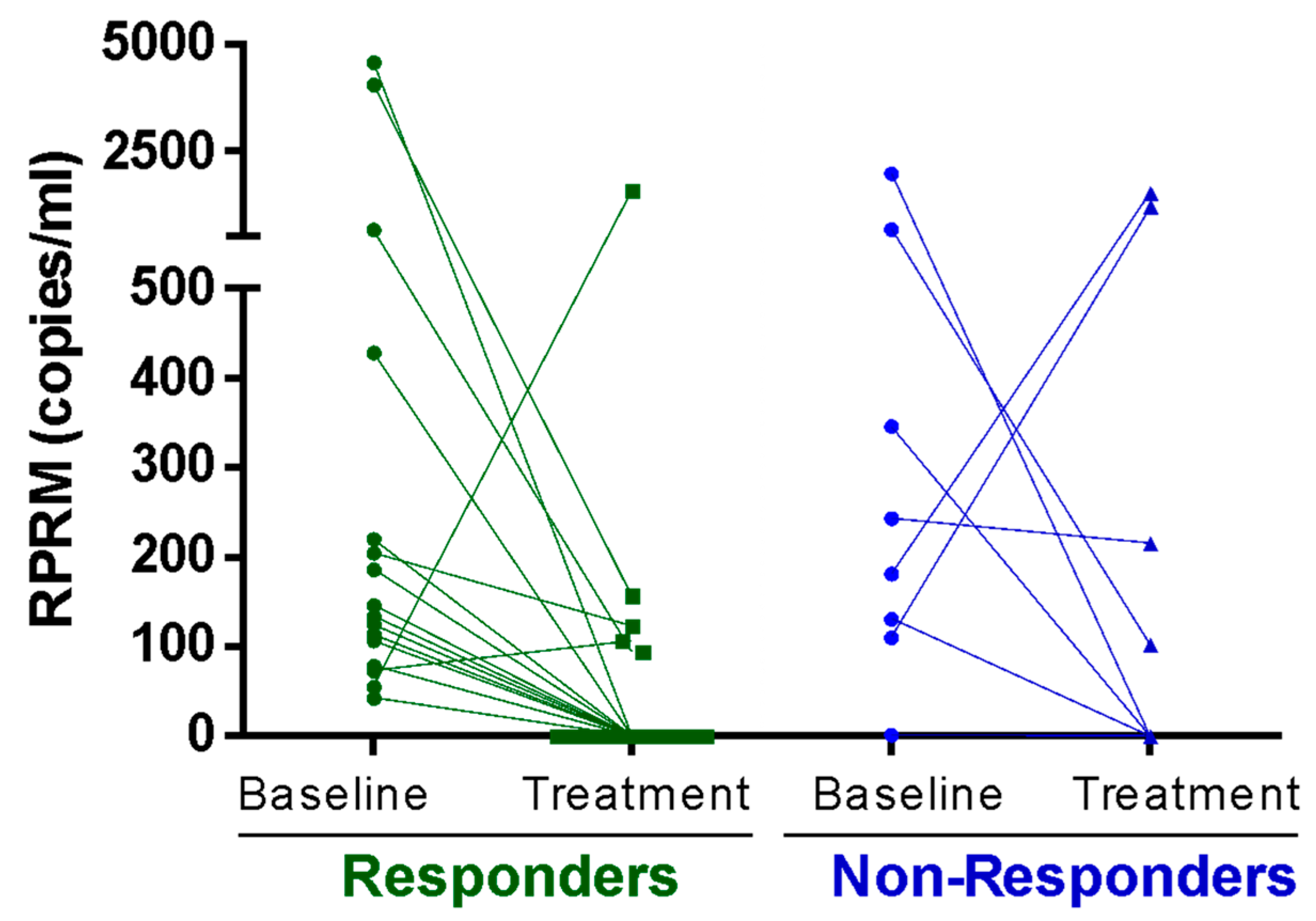Methylated Reprimo Cell-Free DNA as a Non-Invasive Biomarker for Gastric Cancer
Abstract
:1. Introduction
2. Results
2.1. RPRM Promoter Methylation in Gastric Cancer Tissues
2.2. RPRM Promoter Methylation in Paired Tissue and Plasma Gastric Cancer Samples
2.3. Characterization of Methylated RPRM Cell-Free DNA as a Biomarker for Non-Invasive Detection of Gastric Cancer (Cohort 1)
2.4. Characterization of Methylated RPRM Cell-Free DNA as a Biomarker for Monitoring Gastric Cancer Treatment Response (Cohort 2)
2.5. Evaluation of Methylated RPRM Cell-Free DNA Across the Premalignant Conditions and Gastric Cancer (Cohort 3)
3. Discussion
4. Methods
4.1. Clinical Samples
4.2. Molecular Biology Methods
4.3. Enzyme-Linked Immunosorbent Assay (ELISA) Method for the Detection of PG and H. pylori
4.4. Biostatistical Methods
Supplementary Materials
Author Contributions
Funding
Institutional Review Board Statement
Informed Consent Statement
Data Availability Statement
Acknowledgments
Conflicts of Interest
References
- Morgan, E.; Arnold, M.; Constanza Camargo, M.; Gini, A.; Kunzmann, A.T.; Matsuda, T.; Meheus, F.; Verhoeven, R.H.A.; Vignat, J.; Laversanne, M.; et al. The current and future incidence and mortality of gastric cancer in 185 countries, 2020−2040: A population-based modelling study. eClinicalMedicine 2022, 47, 101404. [Google Scholar] [CrossRef]
- Kuzuu, K.; Misawa, N.; Ashikari, K.; Kessoku, T.; Kato, S.; Hosono, K.; Yoneda, M.; Nonaka, T.; Matsushima, S.; Komatsu, T.; et al. Gastrointestinal Cancer Stage at Diagnosis Before and During the COVID-19 Pandemic in Japan. JAMA Netw. Open 2021, 4, e2126334. [Google Scholar] [CrossRef] [PubMed]
- Gómez-Carballa, A.; Bello, X.; Pardo-Seco, J.; Martinón-Torres, F.; Salas, A. Mapping genome variation of SARS-CoV-2 worldwide highlights the impact of COVID-19 super-spreaders. Genome Res. 2020, 30, 1434–1448. [Google Scholar] [CrossRef] [PubMed]
- Shah, S.C.; Gupta, S.; Li, D.; Morgan, D.; Mustafa, R.A.; Gawron, A.J. Spotlight: Gastric Intestinal Metaplasia. Gastroenterology 2020, 158, 704. [Google Scholar] [CrossRef]
- Mabe, K.; Inoue, K.; Kamada, T.; Kato, K.; Kato, M.; Haruma, K. Endoscopic screening for gastric cancer in Japan: Current status and future perspectives. Dig. Endosc. 2022, 34, 412–419. [Google Scholar] [CrossRef]
- Hamashima, C. Update version of the Japanese Guidelines for Gastric Cancer Screening. Jpn. J. Clin. Oncol. 2018, 48, 673–683. [Google Scholar] [CrossRef]
- Liu, M.C.; Oxnard, G.R.; Klein, E.A.; Swanton, C.; Seiden, M.V. Sensitive and specific multi-cancer detection and localization using methylation signatures in cell-free DNA. Ann. Oncol. 2020, 31, 745–759. [Google Scholar] [CrossRef]
- Locke, W.J.; Guanzon, D.; Ma, C.; Liew, Y.J.; Duesing, K.R.; Fung, K.Y.C.; Ross, J.P. DNA Methylation Cancer Biomarkers: Translation to the Clinic. Front. Genet. 2019, 10, 1150. [Google Scholar] [CrossRef]
- Malkin, E.; De Michino, S.; Lambie, M.; Gill, R.; Zhao, Z.; Rostami, A.; Arruda, A.; Minden, M.; Bratman, S. Cell-free DNA topology depends on its subcellular and cellular origins in cancer. JCI Insight 2022, 7, e159590. [Google Scholar] [CrossRef]
- Wu, T.; Giovannucci, E.; Welge, J.; Mallick, P.; Tang, W.Y.; Ho, S.M. Measurement of GSTP1 promoter methylation in body fluids may complement PSA screening: A meta-analysis. Br. J. Cancer 2011, 105, 65–73. [Google Scholar] [CrossRef]
- Church, T.R.; Wandell, M.; Lofton-Day, C.; Mongin, S.J.; Burger, M.; Payne, S.R.; Castanos-Velez, E.; Blumenstein, B.A.; Rosch, T.; Osborn, N.; et al. Prospective evaluation of methylated SEPT9 in plasma for detection of asymptomatic colorectal cancer. Gut 2014, 63, 317–325. [Google Scholar] [CrossRef] [PubMed]
- Luo, H.y.; Wei, W.; Ye, Z.; Zheng, J.; Xu, R. Liquid Biopsy of Methylation Biomarkers in Cell-Free DNA. Trends Mol. Med. 2021, 27, 482–500. [Google Scholar] [CrossRef]
- Han, H.S.; Lee, K.-W. Liquid Biopsy: An Emerging Diagnostic, Prognostic, and Predictive Tool in Gastric Cancer. J. Gastric Cancer 2023, 24, 4–28. [Google Scholar] [CrossRef]
- Bernal, C.; Aguayo, F.; Villarroel, C.; Vargas, M.; Diaz, I.; Ossandon, F.J.; Santibanez, E.; Palma, M.; Aravena, E.; Barrientos, C.; et al. Reprimo as a potential biomarker for early detection in gastric cancer. Clin. Cancer Res. 2008, 14, 6264–6269. [Google Scholar] [CrossRef]
- Ohki, R.; Nemoto, J.; Murasawa, H.; Oda, E.; Inazawa, J.; Tanaka, N.; Taniguchi, T. Reprimo, a new candidate mediator of the p53-mediated cell cycle arrest at the G2 phase. J. Biol. Chem. 2000, 275, 22627–22630. [Google Scholar] [CrossRef] [PubMed]
- Takikawa, M.; Nakano, A.; Krishnaraj, J.; Tabata, Y.; Watanabe, Y.; Okabe, A.; Sakaguchi, Y.; Fujiki, R.; Mochizuki, A.; Tajima, T.; et al. Extrinsic induction of apoptosis and tumor suppression via the p53-Reprimo-Hippo-YAP/TAZ-p73 pathway. Proc. Natl. Acad. Sci. USA 2025, 122, e2413126122. [Google Scholar] [CrossRef]
- Saavedra, K.; Valbuena, J.; Olivares, W.; Marchant, M.J.; Rodriguez, A.; Torres-Estay, V.; Carrasco-Avino, G.; Guzman, L.; Aguayo, F.; Roa, J.C.; et al. Loss of Expression of Reprimo, a p53-induced Cell Cycle Arrest Gene, Correlates with Invasive Stage of Tumor Progression and p73 Expression in Gastric Cancer. PLoS ONE 2015, 10, e0125834. [Google Scholar] [CrossRef] [PubMed]
- Amigo, J.D.; Opazo, J.C.; Garcia-Bloj, B.A.; Alarcon, M.A.; Owen, G.I.; Corvalan, A.H. The Reprimo Gene Family: A Novel Gene Lineage in Gastric Cancer with Tumor Suppressive Properties. Int. J. Mol. Sci. 2018, 19, 1862. [Google Scholar] [CrossRef]
- Schneider, B.G.; Peng, D.F.; Camargo, M.C.; Piazuelo, M.B.; Sicinschi, L.A.; Mera, R.; Romero-Gallo, J.; Delgado, A.G.; Bravo, L.E.; Wilson, K.T.; et al. Promoter DNA hypermethylation in gastric biopsies from subjects at high and low risk for gastric cancer. Int. J. Cancer 2010, 127, 2588–2597. [Google Scholar] [CrossRef]
- Alarcón, M.A.; Olivares, W.; Córdova-Delgado, M.; Muñoz-Medel, M.; de Mayo, T.; Carrasco-Aviño, G.; Wichmann, I.; Landeros, N.; Amigo, J.; Norero, E.; et al. The Reprimo-Like Gene Is an Epigenetic-Mediated Tumor Suppressor and a Candidate Biomarker for the Non-Invasive Detection of Gastric Cancer. Int. J. Mol. Sci. 2020, 21, 9472. [Google Scholar] [CrossRef]
- Shigenobu, Y.; Miyamori, D.; Ikeda, K.; Yoshida, S.; Kikuchi, Y.; Kanno, K.; Kashima, S.; Ito, M. Assessing the Influence of the COVID-19 Pandemic on Gastric Cancer Mortality Risk. J. Clin. Med. 2024, 13, 715. [Google Scholar] [CrossRef]
- Mondal, D.; Shinde, S.; Sinha, V.; Dixit, V.; Paul, S.; Gupta, R.K.; Thakur, S.; Vishvakarma, N.; Shukla, D. Prospects of liquid biopsy in the prognosis and clinical management of gastrointestinal cancers. Front. Mol. Biosci. 2024, 11, 1385238. [Google Scholar] [CrossRef] [PubMed]
- Matsuoka, T.; Yashiro, M. Biomarkers of gastric cancer: Current topics and future perspective. World J. Gastroenterol. 2018, 24, 2818–2832. [Google Scholar] [CrossRef]
- Rendek, T.; Pos, O.; Duranova, T.; Saade, R.; Budiš, J.; Repiska, V.; Szemeš, T. Current Challenges of Methylation-Based Liquid Biopsies in Cancer Diagnostics. Cancers 2024, 16, 2001. [Google Scholar] [CrossRef]
- Sacdalan, D.; Haq, S.U.; Lok, B. Plasma Cell-Free Tumor Methylome as a Biomarker in Solid Tumors: Biology and Applications. Curr. Oncol. 2024, 31, 482–500. [Google Scholar] [CrossRef]
- Geng, Y.; Jin, L.; Tang, G.; Zhao, Z.; Gu, Y.; Yang, D. LiqBioer: A manually curated database of cancer biomarkers in body fluid. Database 2022, 2022, baac077. [Google Scholar] [CrossRef] [PubMed]
- Lai, J.; Wang, H.; Luo, Q.; Huang, S.; Lin, S.; Zheng, Y.; Chen, Q. The relationship between DNA methylation and Reprimo gene expression in gastric cancer cells. Oncotarget 2017, 8, 108610–108623. [Google Scholar] [CrossRef] [PubMed]
- Maeda, M.; Yamashita, S.; Shimazu, T.; Iida, N.; Takeshima, H.; Nakajima, T.; Oda, I.; Nanjo, S.; Kusano, C.; Mori, A.; et al. Novel epigenetic markers for gastric cancer risk stratification in individuals after Helicobacter pylori eradication. Gastric Cancer 2018, 21, 745–755. [Google Scholar] [CrossRef]
- Guo, J.; Li, J.; Chang, J.; Wang, L.; Xi, Y. Value of Methylation Status of RPRM, SDC2, and TCF4 Genes in Plasma for Gastric Adenocarcinoma Screening. Int. J. Gen. Med. 2023, 16, 673–681. [Google Scholar] [CrossRef]
- Strickler, J.H.; Loree, J.M.; Ahronian, L.G.; Parikh, A.R.; Niedzwiecki, D.; Pereira, A.A.L.; McKinney, M.; Korn, W.M.; Atreya, C.E.; Banks, K.C.; et al. Genomic Landscape of Cell-Free DNA in Patients with Colorectal Cancer. Cancer Discov. 2018, 8, 164–173. [Google Scholar] [CrossRef]
- Schoenborn, N.L.; Xue, Q.L.; Pollack, C.E.; Janssen, E.M.; Bridges, J.F.P.; Wolff, A.C.; Boyd, C.M. Demographic, health, and attitudinal factors predictive of cancer screening decisions in older adults. Prev. Med. Rep. 2019, 13, 244–248. [Google Scholar] [CrossRef]
- Leal, A.; van Grieken, N.C.T.; Palsgrove, D.N.; Phallen, J.; Medina, J.E.; Hruban, C.; Broeckaert, M.A.M.; Anagnostou, V.; Adleff, V.; Bruhm, D.C.; et al. White blood cell and cell-free DNA analyses for detection of residual disease in gastric cancer. Nat. Commun. 2020, 11, 525. [Google Scholar] [CrossRef]
- Maron, S.B.; Chase, L.M.; Lomnicki, S.; Kochanny, S.; Moore, K.L.; Joshi, S.S.; Landron, S.; Johnson, J.; Kiedrowski, L.A.; Nagy, R.J.; et al. Circulating Tumor DNA Sequencing Analysis of Gastroesophageal Adenocarcinoma. Clin. Cancer Res. 2019, 25, 7098–7112. [Google Scholar] [CrossRef] [PubMed]
- Romańczyk, M.; Osmola, M.; Link, A.; Druet, A.; Hémont, C.; Martin, J.; Chapelle, N.; Matysiak-Budnik, T. Non-Invasive Markers for the Detection of Gastric Precancerous Conditions. Cancers 2024, 16, 2254. [Google Scholar] [CrossRef] [PubMed]
- Miki, K. Gastric cancer screening by combined assay for serum anti-Helicobacter pylori IgG antibody and serum pepsinogen levels—“ABC method”. Proc. Jpn. Acad. Ser. B Phys. Biol. Sci. 2011, 87, 405–414. [Google Scholar] [CrossRef] [PubMed]
- Leja, M.; Linē, A. Early detection of gastric cancer beyond endoscopy—New methods. Best Pract. Res. Clin. Gastroenterol. 2021, 50, 101731. [Google Scholar] [CrossRef]
- Aikou, S.; Ohmoto, Y.; Gunji, T.; Matsuhashi, N.; Ohtsu, H.; Miura, H.; Kubota, K.; Yamagata, Y.; Seto, Y.; Nakajima, A.; et al. Tests for serum levels of trefoil factor family proteins can improve gastric cancer screening. Gastroenterology 2011, 141, 837–845.e837. [Google Scholar] [CrossRef]
- Huang, Y.; Shao, Y.; Yu, X.; Chen, C.; Guo, J.; Ye, G. Global progress and future prospects of early gastric cancer screening. J. Cancer 2024, 15, 3045–3064. [Google Scholar] [CrossRef]
- Kodama, I.; Koufuji, K.; Kawabata, S.; Tetsu, S.; Tsuji, Y.; Takeda, J.; Kakegawa, T. The clinical efficacy of CA 72-4 as serum marker for gastric cancer in comparison with CA19-9 and CEA. Int. Surg. 1995, 80, 45–48. [Google Scholar]
- So, J.B.Y.; Kapoor, R.; Zhu, F.; Koh, C.; Zhou, L.; Zou, R.; Tang, Y.C.; Goo, P.C.K.; Rha, S.Y.; Chung, H.C.; et al. Development and validation of a serum microRNA biomarker panel for detecting gastric cancer in a high-risk population. Gut 2021, 70, 829–837. [Google Scholar] [CrossRef]
- Ravanidis, S.; Grundler, F.; de Toledo, F.W.; Dimitriou, E.; Tekos, F.; Skaperda, Z.; Kouretas, D.; Doxakis, E. Fasting-mediated metabolic and toxicity reprogramming impacts circulating microRNA levels in humans. Food Chem. Toxicol. 2021, 152, 112187. [Google Scholar] [CrossRef] [PubMed]
- Feng, G.; Lin, Z.; Ou, W.-E.; Su, X.; Yan, Q. A Model-Based Meta-Analysis of Willingness to Participate in Cancer Screening. Int. J. Environ. Res. Public Health 2021, 18, 2580. [Google Scholar] [CrossRef]
- Calvo, A.; Galleguillos, B.; Báez, S.; Díaz, A.; Pruyas, M.; Nilsen, V.E.; Aguayo, G.; Villarroel, L.; Domínguez, A.; Ferreccio, C. Results of a Population-Based Gastric Cancer Screening Program Conducted in Chile 1996-2008. Gastroenterology 2011, 140, S419. [Google Scholar] [CrossRef]
- Eisenhauer, E.A.; Therasse, P.; Bogaerts, J.; Schwartz, L.H.; Sargent, D.; Ford, R.; Dancey, J.; Arbuck, S.; Gwyther, S.; Mooney, M.; et al. New response evaluation criteria in solid tumours: Revised RECIST guideline (version 1.1). Eur. J. Cancer 2009, 45, 228–247. [Google Scholar] [CrossRef] [PubMed]
- Latorre, G.; Silva, F.; Montero, I.; Bustamante, M.; Dukes, E.; Uribe, J.; Corsi Sotelo, O.; Reyes, D.; Fuentes-López, E.; Pizarro, M.; et al. Comparison of OLGA and OLGIM as predictors of gastric cancer in a Latin American population: The ECHOS Study. Gut 2024, 73, e18. [Google Scholar] [CrossRef] [PubMed]
- Schneider, J.K.; Schneider, J.F.; Lorenz, R.A. Creating user-friendly databases with Microsoft Access. Nurse Res. 2005, 13, 57–75. [Google Scholar] [CrossRef]
- Campan, M.; Weisenberger, D.J.; Trinh, B.; Laird, P.W. MethyLight and Digital MethyLight. Methods Mol. Biol. 2018, 1708, 497–513. [Google Scholar] [CrossRef]
- Girgis, H.Z. MeShClust v3.0: High-quality clustering of DNA sequences using the mean shift algorithm and alignment-free identity scores. BMC Genom. 2022, 23, 423. [Google Scholar] [CrossRef]
- Waterhouse, A.M.; Procter, J.B.; Martin, D.M.; Clamp, M.; Barton, G.J. Jalview Version 2—A multiple sequence alignment editor and analysis workbench. Bioinformatics 2009, 25, 1189–1191. [Google Scholar] [CrossRef]
- Agréus, L.; Kuipers, E.J.; Kupcinskas, L.; Malfertheiner, P.; Di Mario, F.; Leja, M.; Mahachai, V.; Yaron, N.; van Oijen, M.; Perez Perez, G.; et al. Rationale in diagnosis and screening of atrophic gastritis with stomach-specific plasma biomarkers. Scand. J. Gastroenterol. 2012, 47, 136–147. [Google Scholar] [CrossRef]




| Statistic | Value | 95% CI |
|---|---|---|
| Sensitivity | 65.00% | 53.52% to 75.33% |
| Specificity | 75.90% | 73.16% to 78.49% |
| Positive Likelihood Ratio | 2.70 | 2.22 to 3.28 |
| Negative Likelihood Ratio | 0.46 | 0.34 to 0.62 |
| Disease prevalence | 7.24% | 5.78% to 8.93% |
| Positive Predictive Value | 17.39% | 14.78% to 20.36% |
| Negative Predictive Value | 96.53% | 95.36% to 97.40% |
| Accuracy | 75.11% | 72.45% to 77.64% |
| Non-Adjusted | Adjusted by Sex and Age | ||||||
|---|---|---|---|---|---|---|---|
| Lesion Grade | Positive n (%) | Odds Ratio (Crude Rate) | 95% C.I. OR | p-Value | Odds Ratio (Adjusted) | 95% C.I. OR | p-Value |
| Normal (No histological analysis was performed) | 34 (18.89) | reference | reference | reference | reference | reference | reference |
| Chronic atrophic gastritis | 167 (24.13) | 1.37 | 0.91 to 2.06 | 0.164 | 1.37 | 0.90 to 2.07 | 0.140 |
| Intestinal metaplasia and low grade dysplasia | 46 (30.07) | 1.85 | 1.11 to 3.07 | 0.020 | 1.60 | 0.93 to 2.75 | 0.091 |
| Early gastric cancer (stage I-II) and high-grade dysplasia | 10 (47.62) | 3.90 | 1.53 to 9.94 | 0.004 | 3.23 | 1.15 to 9.11 | 0.026 |
| Advanced gastric cancer (stage III-IV) | 42 (71.19) | 10.61 | 5.40 to 20.85 | <0.0001 | 9.79 | 4.43 to 21.61 | <0.0001 |
| Chronic atrophic gastritis and gastric intestinal metaplasia/low-grade dysplasia | 213 (25.21) | 1.45 | 0.97 to 2.17 | 0.084 | 1.40 | 0.93 to 2.11 | 0.104 |
| Early gastric cancer (stage I-II)/high-grade dysplasia and advanced gastric cancer | 52 (65.00) | 7.98 | 4.41 to 14.41 | <0.0001 | 6.93 | 3.48 to 13.81 | <0.0001 |
| Test | Cases | Controls | Sensitivity | Specificity | Odds Ratio | ||||
|---|---|---|---|---|---|---|---|---|---|
| n = 19 | n = 92 | % | 95% CI | % | 95% CI | Odds Ratio | 95% CI | p-Value | |
| Methylated RPRM cfDNA | 47.37% | 24.45% to 71.14% | 77.17% | 67.25% to 85.28% | 3.04 | 1.09 to 8.47 | 0.033 | ||
| positive | 9 | 21 | |||||||
| negative | 10 | 71 | |||||||
| PG-I/II ratio | 52.63% | 28.86% to 75.55% | 80.22% | 70.55% to 87.84% | 4.51 | 1.60 to 12.72 | 0.005 | ||
| Positive | 10 | 18 | |||||||
| Negative | 9 | 74 | |||||||
| Combined Methylated RPRM cfDNA or PG-I/II ratio | 78.95% | 54.43% to 93.95% | 63.04% | 52.34% to 72.88% | 6.40 | 1.96 to 20.85 | 0.002 | ||
| Positive | 15 | 34 | |||||||
| Negative | 4 | 58 | |||||||
Disclaimer/Publisher’s Note: The statements, opinions and data contained in all publications are solely those of the individual author(s) and contributor(s) and not of MDPI and/or the editor(s). MDPI and/or the editor(s) disclaim responsibility for any injury to people or property resulting from any ideas, methods, instructions or products referred to in the content. |
© 2025 by the authors. Licensee MDPI, Basel, Switzerland. This article is an open access article distributed under the terms and conditions of the Creative Commons Attribution (CC BY) license (https://creativecommons.org/licenses/by/4.0/).
Share and Cite
Maturana, M.J.; Padilla, O.; Santoro, P.M.; Alarcón, M.A.; Olivares, W.; Blanco, A.; Armisen, R.; Garrido, M.; Aravena, E.; Barrientos, C.; et al. Methylated Reprimo Cell-Free DNA as a Non-Invasive Biomarker for Gastric Cancer. Int. J. Mol. Sci. 2025, 26, 3333. https://doi.org/10.3390/ijms26073333
Maturana MJ, Padilla O, Santoro PM, Alarcón MA, Olivares W, Blanco A, Armisen R, Garrido M, Aravena E, Barrientos C, et al. Methylated Reprimo Cell-Free DNA as a Non-Invasive Biomarker for Gastric Cancer. International Journal of Molecular Sciences. 2025; 26(7):3333. https://doi.org/10.3390/ijms26073333
Chicago/Turabian StyleMaturana, María José, Oslando Padilla, Pablo M. Santoro, Maria Alejandra Alarcón, Wilda Olivares, Alejandro Blanco, Ricardo Armisen, Marcelo Garrido, Edmundo Aravena, Carlos Barrientos, and et al. 2025. "Methylated Reprimo Cell-Free DNA as a Non-Invasive Biomarker for Gastric Cancer" International Journal of Molecular Sciences 26, no. 7: 3333. https://doi.org/10.3390/ijms26073333
APA StyleMaturana, M. J., Padilla, O., Santoro, P. M., Alarcón, M. A., Olivares, W., Blanco, A., Armisen, R., Garrido, M., Aravena, E., Barrientos, C., Calvo-Belmar, A., & Corvalán, A. H. (2025). Methylated Reprimo Cell-Free DNA as a Non-Invasive Biomarker for Gastric Cancer. International Journal of Molecular Sciences, 26(7), 3333. https://doi.org/10.3390/ijms26073333







